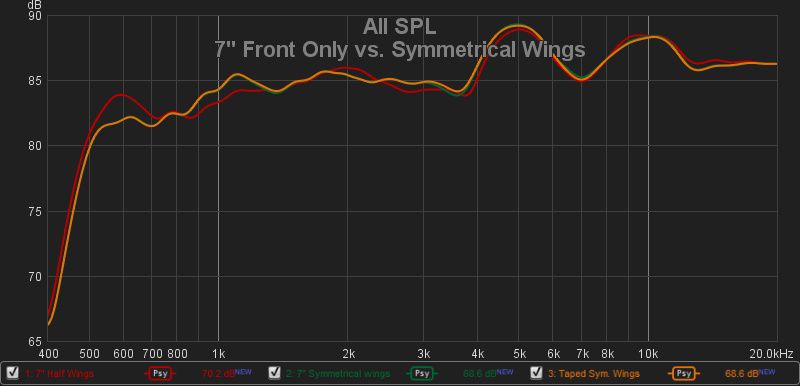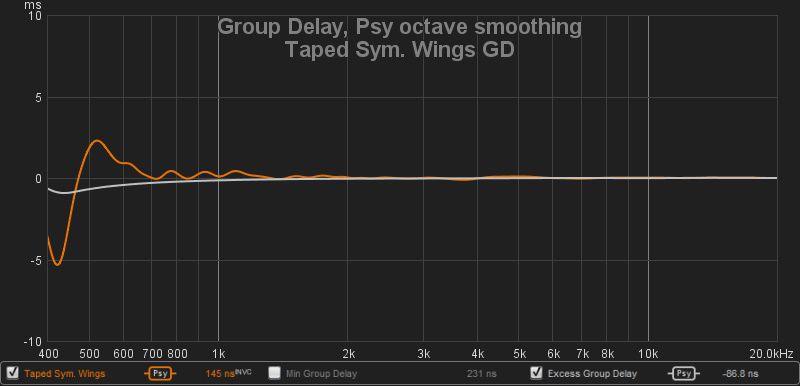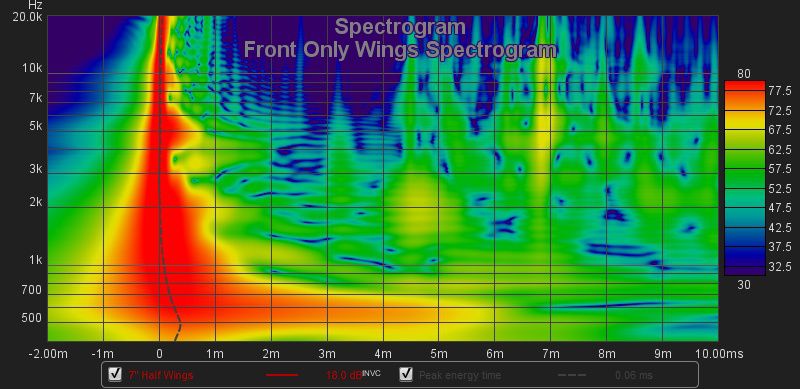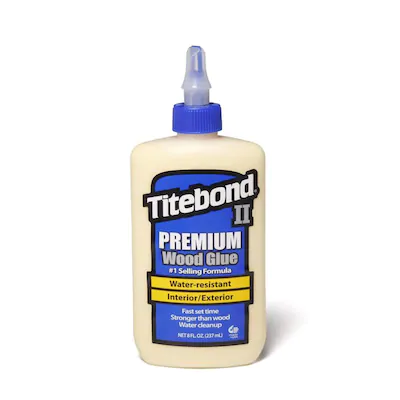-
Posts
3556 -
Joined
-
Last visited
-
Days Won
2
Content Type
Forums
Events
Gallery
Everything posted by Rudy81
-

Double Stack ESS AMT-1 with Wings--Possible Kit for Heritage
Rudy81 replied to Chris A's topic in Technical/Restorations
In my never ending quest to get the maximum performance out of my system, I recently found that there is more to be done besides EQ at the 3 foot distance. I have been fighting a battle with a particular resonance which I could not tame by enhancing the internal bracing and open cell foam absorption of my bass bins. Last week, in thinking about what Audyssey did in my system before I abandoned that process, I took a shot at running plots at the LP. I found quite a different response, as one would expect, at the LP vs. the 3 foot point due to room interaction. The major differences were related to the LF portion of the sweep, again, as one would expect. I made some changes to the EQ based on the problems shown by the plot at the LF portion of the sweep. I am now glad to report that the problem I had been fighting for months with resonance....is gone! I wish I would have done this before spending quite a bit of money and time in open cell foam installation in the bass bins. The EQ required was not that great, but it made a huge difference in what I hear at the LP. The performance of the AMT is so dang good, it needs no EQ at all in my room. As we all know, room problems are mostly centered around LF unless you are listening to your speakers in a shower stall. 90% of my EQ is all in the range below 1kHz near which I have my crossover point. I estimate I am currently crossing near 900Hz. -

Double Stack ESS AMT-1 with Wings--Possible Kit for Heritage
Rudy81 replied to Chris A's topic in Technical/Restorations
Update on my question about toe-in. Spent some time this afternoon listening for the changes in sound depending on toe-in. My original setup has the AMT stack pointed to a spot which crosses my LP about 2 feet either side of my ears. I originally had this with my Oris and preferred that orientation. Today, I aimed the AMT stack at my ears and listened for a while, various test discs and music favorites. My initial impression was that the image had narrowed somewhat, but the most noticeable change was the narrowing of the soundstage and a decrease in depth. After a good while, I returned the stack to its original position and validated my initial impression. With the AMTs aimed a couple of feet outside my ears, I get a much fuller and wider soundstage. The image is still very strong, but seems wider, allowing some lateral head movement without losing the nicely defined image. Depth also returned to a much deeper soundstage. Granted, this is all in my room....YMMV. The hf quality did not seem to diminish at all when pointed outside my LP. For now, the original setup is preferred. -

Double Stack ESS AMT-1 with Wings--Possible Kit for Heritage
Rudy81 replied to Chris A's topic in Technical/Restorations
@Chris A, I need a bit of advice on stack alignment relative to LP. When using my Oris, I always toed them out a little due to high frequency beaming....which I have not found to be the case with the AMTs. I just started playing around with aiming the center of the AMT at the LP. Any downside to pointing the AMTs at the LP vs. toe out? -

New Project: Chop top LS with Double Stack ESS AMT-1
Rudy81 replied to Thaddeus Smith's topic in Technical/Restorations
With all modern gear, you should not have any issues with gain structure.....seems more applicable to strictly all pro gear. You will only have an issue if you happen to have a noisy component in the chain. Just reading the papers on gain structure gives me a headache. -

New Project: Chop top LS with Double Stack ESS AMT-1
Rudy81 replied to Thaddeus Smith's topic in Technical/Restorations
Most excellent! -

New Project: Chop top LS with Double Stack ESS AMT-1
Rudy81 replied to Thaddeus Smith's topic in Technical/Restorations
How loud is the fan on those amps? -

Double Stack ESS AMT-1 with Wings--Possible Kit for Heritage
Rudy81 replied to Chris A's topic in Technical/Restorations
My experience is that the further back you move the drivers, the more you lose some of the 'airy' '3d soundstage' they provide in their raw form. The waveguides we are building and have built most assuredly help the diaphragm below 2kz. Since I don't need to cross very low, I have even toyed with the idea of going back to the raw drivers alone since they just sound so awesome! Even with the drivers about 6" back from the edge, with the 7" wings, they just lose just a little bit of the magic. In this case, it is a worthwhile trade-off. As in all things audio, it is always about trade-offs. Honestly, for how easy it is to build a set of waveguides, it will be worth your time to build both. Heck, you really don't even need to glue them. Just a few brad nails to hold the shape should give you some practical prototypes. I posted the graphs of each wing and the no-wing performance to help with the 'numbers' decision. BUT, it is the sound that should have the last say. BTW, I originally hung my wings in the air as you are doing, but I just didn't like the look.....and that was with the 7" wings. Edit: In looking at your pictures, I noticed your bass bins are close to the wall behind them. Please let us know your experience with the dipole drivers close to the wall. I am about 3.5' to 4' away from the wall behind them. I am wondering if you will experience any issues being so close to a reflecting surface.....hopefully not. I know lot's of folks are also close to the wall and could use your review on the subject. -

Double Stack ESS AMT-1 with Wings--Possible Kit for Heritage
Rudy81 replied to Chris A's topic in Technical/Restorations
Not at all. I decided that it was too large for me, but I used the same design for my current 7" wings. I gave what you see in the pictures to @Thaddeus Smith so he could take it home and see if it fits his plans. We can build a nicer version once he decides what he likes best. He has heard mine and seen the relative size of the 7" wings. -

New Project: Chop top LS with Double Stack ESS AMT-1
Rudy81 replied to Thaddeus Smith's topic in Technical/Restorations
Absolutely! -

New Project: Chop top LS with Double Stack ESS AMT-1
Rudy81 replied to Thaddeus Smith's topic in Technical/Restorations
The other issue I had with the larger wings is that I could not place such a large structure on my center channel....not enough room before it would hit my screen frame. Also, I don't need the lowest of crossover capability. Those LaS bins do look good with the larger wings on top! Overall should be a simple build if you go with plywood of your choice. If you plan on staining, you can find various types of plywood with stain quality sides at the lumber yard I mentioned to you. -

Double Stack ESS AMT-1 with Wings--Possible Kit for Heritage
Rudy81 replied to Chris A's topic in Technical/Restorations
I think we are so far along in our discovery that we are now dealing with the very small changes and improvements. In my case, the symmetric wings were done to maximize the performance of the 7" front only wings. I also decided on the 7" vs. the longer wings for various reasons. Mainly, I don't need to cross at 500hz. I can cross up to 1.2khz if needed. So, for me, I couldn't justify the much larger wings for an improvement I didn't need. The size, weight and aesthetics of the larger wings didn't justify going that route for my needs. As a matter of fact, I just moved my xover point closer to 900hz just to see how it sounds. I will live with that for a week or so and see how that sounds. I bet that Chris could tell you a lot about small changes between the front only and symmetrical wing setups. After quite a bit of time and energy working on this project, we are closing in on what can be done with just a double stack simple waveguide setup. Now, if anyone can build a true horn for the stack, I suspect that would open up another area of improvement.....how much, who knows. So yes, the changes are minor, but that is simply a result of how far along we are in our discovery of what can be done. I sure hope someone can improve on what we have done! Then, we can all benefit. -

Double Stack ESS AMT-1 with Wings--Possible Kit for Heritage
Rudy81 replied to Chris A's topic in Technical/Restorations
.... -

Double Stack ESS AMT-1 with Wings--Possible Kit for Heritage
Rudy81 replied to Chris A's topic in Technical/Restorations
The tape I used at the seam is not as visible as the picture would suggest. It basically disappears from a few feet away. The bow tie top is just held on with double sided tape, giving it a more complete look yet allowing easy removal of the drivers. -

Double Stack ESS AMT-1 with Wings--Possible Kit for Heritage
Rudy81 replied to Chris A's topic in Technical/Restorations
I just realized I inadvertently changed the scale of the Spectrogram between screenshots, so I will upload a change shortly to make them match. This is the final product without the top 'bow tie'. -

Double Stack ESS AMT-1 with Wings--Possible Kit for Heritage
Rudy81 replied to Chris A's topic in Technical/Restorations
I have now installed one of my latest creations. 7" Symmetrical Wing structure for the double stack AMT. I will post pictures shortly, but here are the plots. First some notes on the build: - 7.25" Symmetrical, front and back, wings. - No dowel rods on this build, much simpler to build and install drivers. - Full wrap around on sides of wings. - Instead of putty, I used black electrical tape to make a continuous, smooth seam where the AMT meets the wing. @Chris A, I will send you the REW file in case you wish to expand on my results. Mic was placed 3 feet from Stack, level with the middle of the stack. Calibrated mic and REW. No EQ, No timing delay at all, no crossover in use. Sweeps run from 400hz on up to protect the drivers somewhat. -

New Project: Chop top LS with Double Stack ESS AMT-1
Rudy81 replied to Thaddeus Smith's topic in Technical/Restorations
If you are gluing raw lumber, in my experience, all you need is something like Titebond II Premium wood glue. I have tried to break apart things I simply glued and brad nailed together. The lumber splinters and breaks, but the joint stays. I know many of us, including myself, tend to over engineer things. You can use what you already got, just be very careful. Not a big deal. -

New Project: Chop top LS with Double Stack ESS AMT-1
Rudy81 replied to Thaddeus Smith's topic in Technical/Restorations
Be very, very, very careful with that stuff.....I know! DO NOT get that stuff on your hands or any exposed skin and allow it to dry. Many builds ago, I think the SPUD subs, I got that stuff all over my hands and I did not read the product warnings. I wrongly assumed it would easily come off later like wood glue. I worked with it all day and allowed it to dry on my skin. I spent about a week waiting for that stuff, which turned dark and very rough, to come off....it was a horrible experience and I will not use that stuff. My experience was with the expanding Gorilla Glue.... Also, If you get any on a surface you later wish to paint, you will always 'see' where the glue is. -
At the time I was using Tang Band 1808 drivers. If I had been more knowledgeable at the time, I would have purchased the TB 1772 drivers, which have better Q for the Oris.
-
In my experience, if you note a large dip at the xover point, after setting the timing, the GD will confirm the need for polarity inversion of one of the drivers. The GD shows a huge change in GD at that point. Of course, take my comments with a grain of salt as I am merely a student of the magic arts of audio and REW.
-
Joe, you are correct. I have run the Oris in a purely OB setup and would go back to total OB if I could figure out the LF problem. I have considered high end OB bass drivers, but they start at $500 plus and I'm not sure they can reach much below 30hz. Granted, not a lot of music there, but it does occur. As far as the cleanest bass I have heard in my room, it was my OB setup. But, it did not have the 'punch' and in your chest performance that my current bass bins have. In all fairness to OB in general, I was using my Eminence Kappalite 3015LF drivers which are not ideal for OB. I left the project before purchasing several thousand dollars worth of high end LF drivers. Maybe sometime I can revisit. I am eagerly following @rplace and his PAP clone project. In my case, I used 3 RSW 15 subs to hold up the low end.
-
@rplace, I just sent you a PM concerning the whizzer cone behavior. I also looked back at my sweeps from the Fostex and TB drivers in the ORIS and I do not have that phase anomaly. I will keep checking.
-
Just looking at the blue graph above, I would say you need to invert the polarity on your HF driver, which correlates with the GD anomaly you posted above that. Give that a try and see what you get.
-
If a buyer is willing to arrange and pay for packing, shipping and delivery, I'm good with that once payment is made. These things are pricey to ship once the driver mounting ring is attached, and I don't think you can remove it without damaging the horns. Sad, because I still have the original wooden box used to ship them from Europe. Maybe BD-Designs should look at a mounting ring method that doesn't involve fusing the ring and horn permanently.
-
Sounds interesting as an option. Thank you for letting me know. Due to dangers of shipping, for now, it is local but may go that route eventually.














